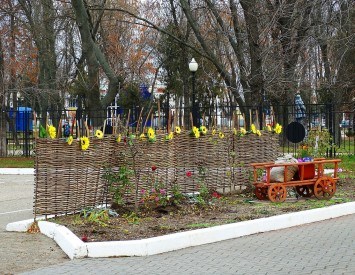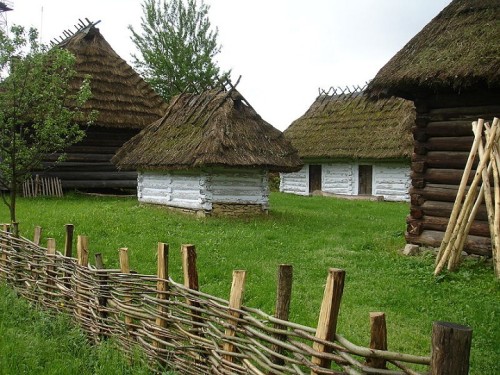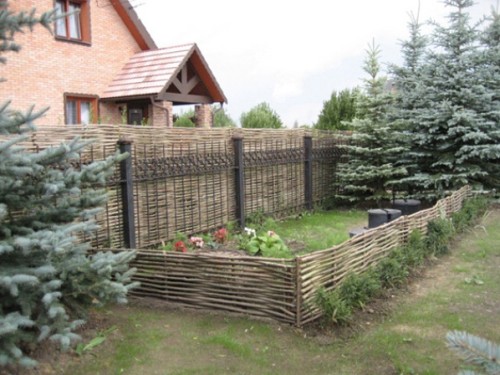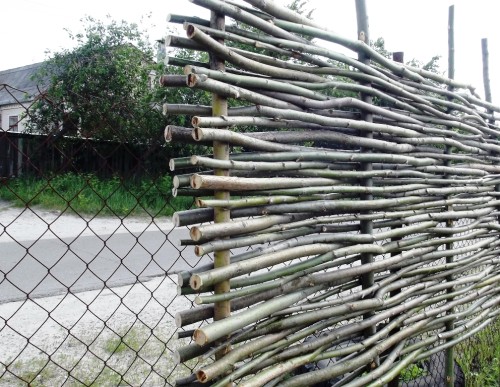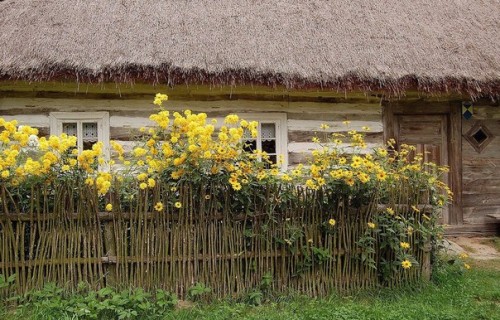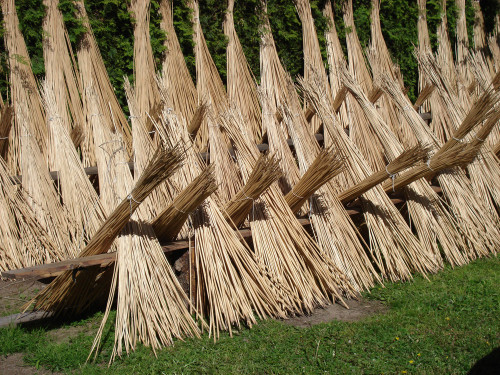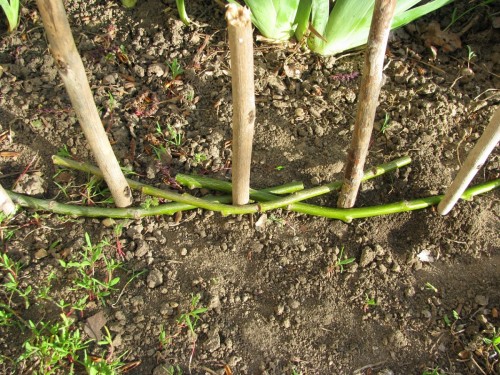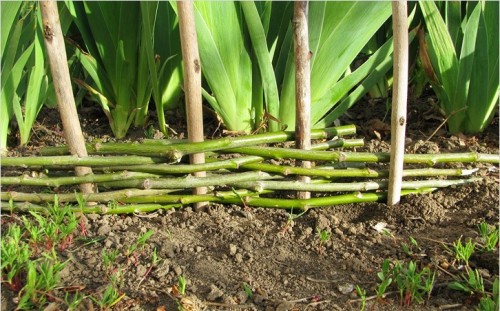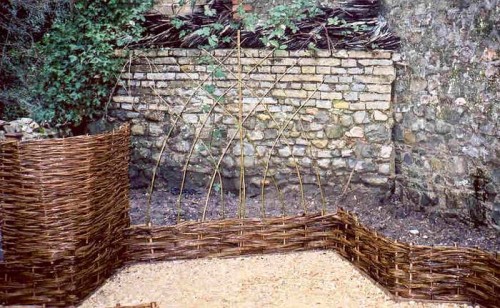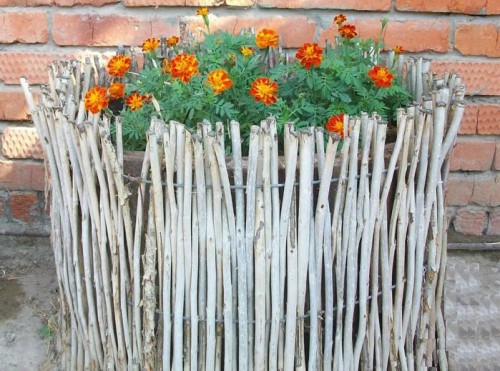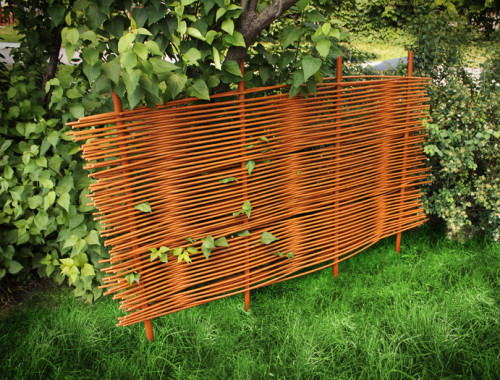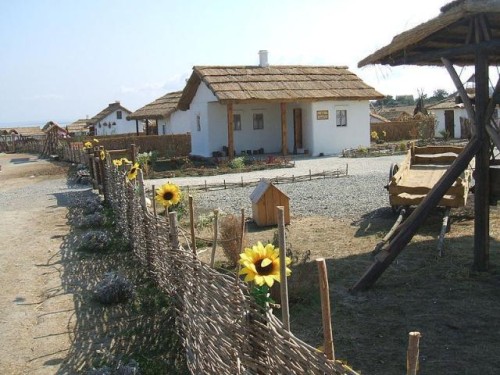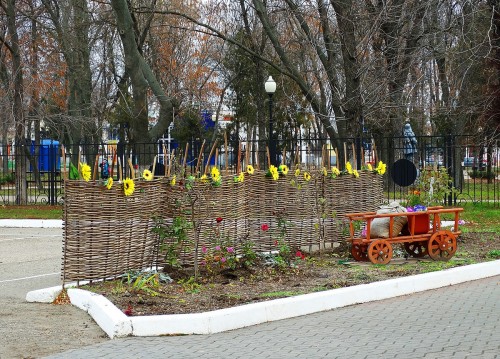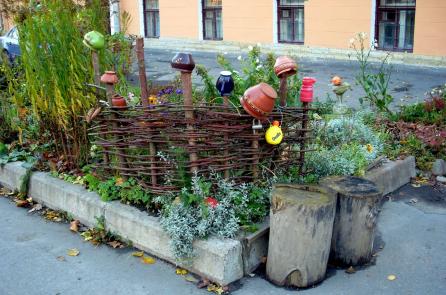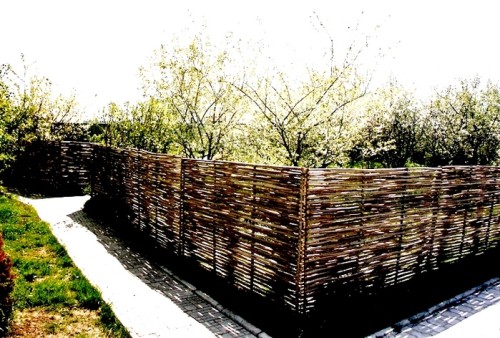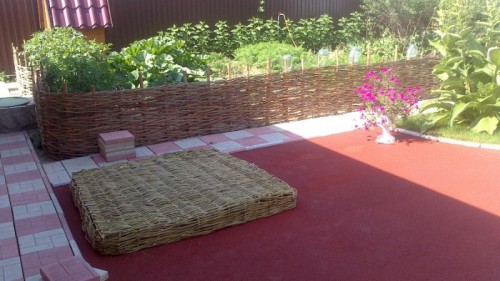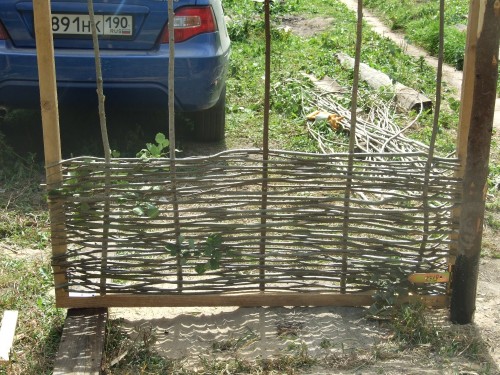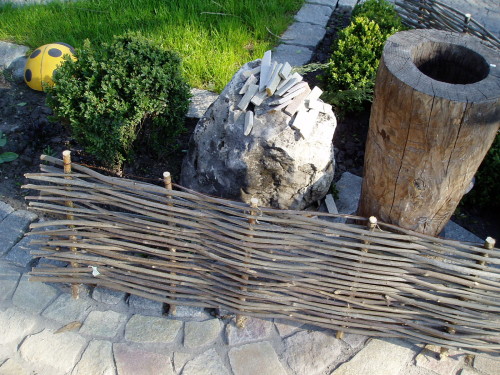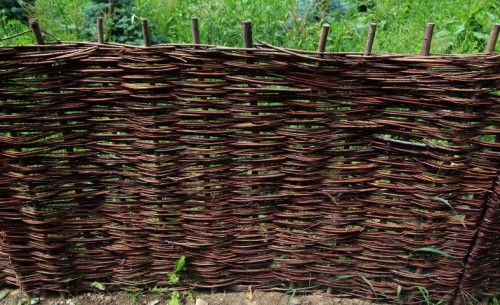A wicker is a rather colorful fence created in an ethnic style. Previously, a braid or, as it was also called, Tyn was an obligatory attribute of each courtyard of the countryside. Over time, people refused such fences, because more modern materials appeared: metal, brick, cement. The circumstances became more serious, and the fences became stronger. But today, more and more often such a decorative design element as a wand can be seen only in the rural outback, but also on modern personal plots, and located even in the center of the metropolis. The braid can be done in the country with your own hands, and it is not at all necessary to put security functions on it - using such a fence, you can fenced a flowerbed, flower garden, garden, recreation area, gazebo, etc. This building will fit very beautifully into any interior, especially if you want to add notes of ethnic style.
Content
Blade: Advantages and disadvantages
A wicker fence will give the personal plot not only a rural form, but also of special sincerity. Especially the wattle fence looks great if you add ethnic design solutions around it - this will give a special flavor to your home.
Blade: Virtues:
- Made of environmental material.
- It is inexpensive.
- Easy to manufacture.
- You can disassemble and collect several times.
- Original solution.
- Great decor element.
- For construction, you can use any material: not only the branches that remained after the rejuvenation of shrubs and trees, but also the thin PVC pipes.
Blade: Disadvantages:
- Short -lived.
- It is used only as a decoration, as it does not carry full -fledged functions of the fence.
- It breaks quickly, even if you make a slight physical effort.
Today, wattlerous can be seen in ethno cafes and restaurants, in kindergartens and in playgrounds. This fence is beautiful and it is often used as jewelry of resting places. Very original wicker looks in a large city surrounded by all the benefits of civilization. But in his area, the braid can fenced the flowerbed, lawn, gazebo, barbecue, the main thing is to choose the right accessories and decoration.
Do -it -yourself wicker: advice for beginners
In order for your improvised wicker fence to be fame, and last as long as possible, remember these simple advice:
- The durability of the wattle fence depends on the speed with which the branches rot, so that the fence serves faithfully for the truth as long as possible, it is necessary to help him in this - to protect against decay. The cheapest antiseptic is car oil - they need to treat the surface of the branches. A significant minus of this tool: the branches will acquire a dark color, and it will be contraindicated to touching the fence - the oil is not absorbed and does not dry, which means that the waddle will leave fat traces on any object that will affect it.
- Another way to extend the life of the wattle fence is a drainage layer that will prevent the contact of the branches with the ground. As a drainage, you can use crushed stone or sand, and one can be used. First you need to dig a trench with a depth of 50 cm, then fill the drainage layers and install vertical pegs.
- In order to protect the support pegs, the part that will be underground must be charged. This can also be greased with bitumen.
- To facilitate the installation of pegs, you can first drive scrap into the ground - thanks to this a peculiar hole is formed. Now you can quickly install pegs in these holes.
- Weave a wicker tie the branches between the stakes. So that the lower and upper branches do not slide from the pegs, it is necessary to tie the first and last branch with wire to the middle branches.
- You should not use dry branches to create a wattle fence that lie for a long time, because they do not have elasticity. As soon as you try to bend such material a little, the branch will crack right away. That is why soaked branches are needed - they will soften, after which it will be more interesting to do with them.
- To create a beautiful wattle, choose the same branches - both in thickness and in length.
- When choosing branches for pegs, remember that 50 cm will be hidden underground, which means that the length should be the corresponding height of the fence.
- If you do not get up to the top of 10 cm, then you can use the pegs with decor elements.
- Think over the decor elements - the wicker looks much richer if it is decorated with traditional rural "jewelry".
- The braid can be screwed to the grid of a rabid or a metal fence - so you will not only decorate the home, but also hide the yard from prying eyes.
How to make a wicker: preparatory stage
Blade: how to prepare material
Have you decided to build a wicker with your own hands? Then you need to know the secrets of the harvesting of the material.
- The raw materials for manufacturing waters are harvested in January - at this time you definitely will not harm the trees.
- Go to the forest or to any other place where the trees grow and where you can freely cut the right number of branches.
- The branches should be flexible and have a length of at least 50 cm, and the diameter is at least 1-2 cm.
- Experiment: select branches of different colors and shades.
- Before starting to weave the fence, the branches must be soaked for at least a day in water - in any container, so that the liquid is completely covered with raw materials.
Which branches are suitable for the manufacture of wattle
For some reason, there is a stereotype according to which the branches of such trees are ideal for the construction: willow, birch, apple tree, kizil, walnut, pine. In fact, this is not entirely true, because the braid can be made from any tree breed.
Of course, the most successful choice is long and flexible branches of trees and shrubs: willow and hazel. But if you fantasize a little, then you can weave an excellent fence from another raw material, for example, by collecting Rogoz (reeds), straw bunches, birch, turf or even Amur grapes. Aspin’s one -year shoots will fit for the manufacture of a wattle fence.
Give preference to direct and flexible branches of trees and shrubs that grow near reservoirs. It is believed that it is precisely such branches that are more nourished by moisture, they will have a small core and a very smooth surface.
If you turned your eyes to the straw, then take rye: it is more durable and it has long internodes. If it is well soaked, then such straw retains flexibility well, becomes elastic and suitable for weaving. In addition, this straw has a very beautiful color, although, in which case, a wicker from this material is easily painted with aniline paints - in any color profitable for you.
But in order to make a braid from reeds (rogos), raw materials must be collected from August and ending with October.
How to make a wicker: work process
First of all, you need to decide on the material from which you will weave the fence. Then - set it with a place and decoration.
The wicker consists of support (base) and “body” of the fence (rods).
Blade: Preparing the base
- As the basis of the wattle fence, you can use the most diverse branches - pegs that are driven into the ground at about the same distance from each other.
- The pegs must be driven into the ground by at least 20 cm, but in order for the structure to withstand even strong winds and the sediment of the earth, it is necessary to deepen branches by 50 cm.
- The diameter of the pegs for the base should be at least 5 cm.
- The most reliable stakes are obtained from larch.
- Wooden pegs can be replaced with metal or plastic. For these purposes, you can use both reinforcement and PVC pipes. They can be painted in a convenient color for you, and put plugs in hollow pipes. Thanks to this, the design will be able to stand for a very long time.
- If you use wooden stakes, treat them with an antiseptic, varnish, Pinotex impregnation, paints - this will prevent the process of decay and improve the strength of the base. Slices are best charged or treated with an antiseptic.
- Do not forget to make drainage for the base - from sand and gravel.
- The pegs should stand at a distance of not more than 50 cm, but it is better to put them more often-after about 30-40 cm from each other.
- The height of the wattle is chosen individually.
Bold: Prepare rods
- The most important requirement for rods is flexibility.
- If you do not have freshly cut rods, you need to soak during the day those that have been cut for a long time. But if the rods are in the water for too long, they can get black.
- You can soften the rods with steam - arrange a steam bath with them and they will become more flexible. You can also put under a wet burlap.
- The rods can be painted in any color - with paints or plant dyes. For example, a yellow fence will be thanks to onion husks and birch leaves, and brown - thanks to a decoction of branches and black alder. You can use potassium permanganate, stain, etc.
- Before starting painting, you need to remove the tannins - they are found in the bark in many plants. In order to do this, you need to put the branch in a soap solution for a couple of hours.
- If you are not going to paint the branches, then do not clean them of the bark - so the waddle will look very natural.
Weave horizontal wove
- Take straight and thick rods (reinforcement, pipe, etc.) and build the basis of the future fence.
- If the branches are thin, place them closer to each other.
- Take the branch and take it in turn between all vertical rods.
- Do not forget that the branch should braid the rods in turn: lumpy, then to the right side and so on, until the end of the fence (sections of the fence).
- Weaving begins with the thick end of the branch!
- Alternate weaving - the branches should take turns brawls in turn, both on the right on the left and from left to right.
- The next branch should not repeat the path of the previous one: if you started to braid the first peg on the right, then the next branch should braid it on the left, then, the next branch turns back on the right, etc.
- Thick and thin ends of the branches should be distributed evenly along the fence.
- The thickness of the wattle fence should be the same.
- After you have achieved the desired height of the fence, it is necessary to adjust the length of the branches - this can be done using a secateur or garden knife.
- Do not forget about the locks - these are the ends of the rods that are attached using wire to pegs and other branches.
Weave a vertical wicker
- The pegs are driven as described above.
- Several branches are tied to pegs horizontally - these are the strips to which the rest of the branches will be attached.
- The branches are installed vertically - they braid horizontal strips.
- The thick end of the branches should rest against the ground.
- The rods are tied on top: you can make it with a wire or rope, or you can weave several branches horizontally.
PVC pipe
If you have not prepared twigs for the construction of a wattle fence, then you can build it from thin pvc pipes. The specificity of the work is exactly the same as with natural raw materials.
- Cut the pipe into the tubes of the required length. Vertical pegs should be more authentic.
- Get peg into the ground.
- Bend the peg with tubes, starting from below: first on the left, then on the right, etc. Until the material ends or until you reach the desired length.
- Cut the pipe on the sides.
How to decorate a wicker
- It is believed that sunflowers and nyvyniki were necessarily planted near the wattle fence - this is a classic decoration for this fence. Sunflower may well be artificial: plastic, made of polymer clay, from fabric, etc.
- Near the wattle fence, the late chrysanthemum, chamomile, gladioli, asters, dolphinium, nasturtium look great.
- The wicker can be a good support for climbing plants.
- Near the wattle fence you can put a colorful bench - knocked out of stumps and boards.
- On top of pegs you can hang clay pots, children's boots, etc.
